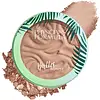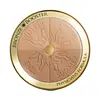What's inside
What's inside
 Key Ingredients
Key Ingredients

 Benefits
Benefits

 Concerns
Concerns

 Ingredients Side-by-side
Ingredients Side-by-side

Talc
AbrasiveSynthetic Sapphire
Mica
Cosmetic ColorantDimethiconol Stearate
EmollientIsostearyl Neopentanoate
EmollientOctyldodecyl Stearoyl Stearate
EmollientAstrocaryum Murumuru Seed Butter
EmollientParfum
MaskingAstrocaryum Tucuma Seed Butter
EmollientTheobroma Grandiflorum Seed Butter
Skin ConditioningAscorbyl Palmitate
AntioxidantCitric Acid
BufferingGlyceryl Oleate
EmollientGlyceryl Stearate
EmollientLauroyl Lysine
Skin ConditioningLecithin
EmollientPolybutene
Tin Oxide
AbrasiveTocopherol
AntioxidantAluminum Hydroxide
EmollientCaprylyl Glycol
EmollientHexylene Glycol
EmulsifyingPhenoxyethanol
PreservativeIron Oxides
CI 15850
Cosmetic ColorantTitanium Dioxide
Cosmetic ColorantTalc, Synthetic Sapphire, Mica, Dimethiconol Stearate, Isostearyl Neopentanoate, Octyldodecyl Stearoyl Stearate, Astrocaryum Murumuru Seed Butter, Parfum, Astrocaryum Tucuma Seed Butter, Theobroma Grandiflorum Seed Butter, Ascorbyl Palmitate, Citric Acid, Glyceryl Oleate, Glyceryl Stearate, Lauroyl Lysine, Lecithin, Polybutene, Tin Oxide, Tocopherol, Aluminum Hydroxide, Caprylyl Glycol, Hexylene Glycol, Phenoxyethanol, Iron Oxides, CI 15850, Titanium Dioxide
Mica
Cosmetic ColorantDiisostearyl Malate
EmollientSynthetic Wax
AbrasiveNylon-12
Ethylhexyl Palmitate
EmollientPolybutene
Lauroyl Lysine
Skin ConditioningDimethicone
EmollientDimethicone/Methicone Copolymer
Inositol
HumectantMaltodextrin
AbsorbentMucuna Pruriens Seed Extract
AstringentKaolin
AbrasiveOctyldodecyl Stearoyl Stearate
EmollientCaprylyl Glycol
EmollientPhenethyl Alcohol
MaskingIron Oxides
Synthetic Fluorphlogopite
Tin Oxide
AbrasiveTitanium Dioxide
Cosmetic ColorantCI 19140
Cosmetic ColorantMica, Diisostearyl Malate, Synthetic Wax, Nylon-12, Ethylhexyl Palmitate, Polybutene, Lauroyl Lysine, Dimethicone, Dimethicone/Methicone Copolymer, Inositol, Maltodextrin, Mucuna Pruriens Seed Extract, Kaolin, Octyldodecyl Stearoyl Stearate, Caprylyl Glycol, Phenethyl Alcohol, Iron Oxides, Synthetic Fluorphlogopite, Tin Oxide, Titanium Dioxide, CI 19140
 Reviews
Reviews

Ingredients Explained
These ingredients are found in both products.
Ingredients higher up in an ingredient list are typically present in a larger amount.
Caprylyl Glycol is a humectant and emollient, meaning it attracts and preserves moisture.
It is a common ingredient in many products, especially those designed to hydrate skin. The primary benefits are retaining moisture, skin softening, and promoting a healthy skin barrier.
Though Caprylyl Glycol is an alcohol derived from fatty acids, it is not the kind that can dry out skin.
This ingredient is also used as a preservative to extend the life of products. It has slight antimicrobial properties.
Learn more about Caprylyl GlycolThis ingredient comes from a fatty acid (lauric acid) and amino acid (lysine). It is used to add a silky feel to cosmetics.
According to a manufacturer, its fatty acid base leaves a silky feeling on the skin. It also has emollient properties because of this. Emollients help soften skin by preventing water from evaporating.
Lauroyl lysine is barely soluble in water.
Learn more about Lauroyl LysineMica is a naturally occurring mineral used to add shimmer and color in cosmetics. It can also help improve the texture of a product or give it an opaque, white/silver color.
Serecite is the name for very fine but ragged grains of mica.
This ingredient is often coated with metal oxides like titanium dioxide. Trace amounts of heavy metals may be found in mica, but these metals are not harmful in our personal products.
Mica has been used since prehistoric times throughout the world. Ancient Egyptian, Indian, Greek, Roman, Aztec, and Chinese civilizations have used mica.
Learn more about MicaOctyldodecyl Stearoyl Stearate is created from stearic acid.
It is an emollient and thickens the lipid (oil) portion of a product. Due to its emollient properties, it may not be fungal-acne safe.
Polybutene is used to help control the viscosity of a product. This just means it helps adjusts the texture.
It is a polymer and does not get absorbed into the skin due to its large size.
Studies found this ingredient did not irritate skin in concentrations below 15%.
Learn more about PolybuteneTin Oxide is an inorganic oxide used to add opacity and volume to a product. In nature, it is already found in mineral form. The main ore of tin is an opaque and shiny mineral called casseterite.
Tin Oxide helps remove translucency in a product, or make it more opaque. Besides adding opacity, tin oxide is used for bulking to add volume.
Titanium dioxide is a mineral UV filter widely used in sunscreens and cosmetics.
It is one of only two UV filters officially classified as “mineral” by regulatory agencies, the other being zinc oxide.
Titanium dioxide provides broad-spectrum protection mostly in the UVB and UVAII range, with some protection in the UVAI range.
While its UVA protection isn’t as strong as zinc oxide’s, the difference is minor.
A common myth is that mineral UV filters reflect UV light. However, modern research shows titanium dioxide absorbs UV radiation like chemical filters (~95% absorption & 5% reflection).
Thanks to its non-irritating nature, titanium dioxide is suitable for sensitive, acne-prone, or redness-prone skin. It is unlikely to cause "eye sting" like other sunscreen ingredients.
A major drawback of this ingredient is its white cast and thick texture. This is why mineral sunscreens often leave a white cast and are less cosmetically elegant than chemical/hybrid sunscreens.
To improve white cast and spreadability, micronized or nano-sized titanium dioxide is often used.
There are ongoing concerns surrounding nano-titanium oxide's impact on marine ecosystems.
There is no conclusive evidence that any form of titanium oxide (or any other sunscreen ingredients) will cause harm to marine ecosystems or coral reefs. The science is still developing but many consumers are keeping a close eye on this issue.
Please note, many destinations have reef-safety sunscreen rules. For instance, the U.S. Virgin Islands advises all visitors to use non-nano mineral sunscreens.
Nano mineral sunscreens once raised safety concerns about absorption into skin.
Extensive research has shown that they do not penetrate healthy or damaged skin; they remain safely on the surface and the top layer of dead skin (stratum corneum).
You'll likely find titanium dioxide bundled with alumina, silica, or dimethicone. These ingredients help make titanium dioxide highly photostable; this prevents it from interacting with other formula components under UV light.
Learn more about Titanium DioxideThis ingredient is a combination of red, black, and yellow iron oxide pigments. This combination of colors is usually found in foundation, because it results in a "skin" color.